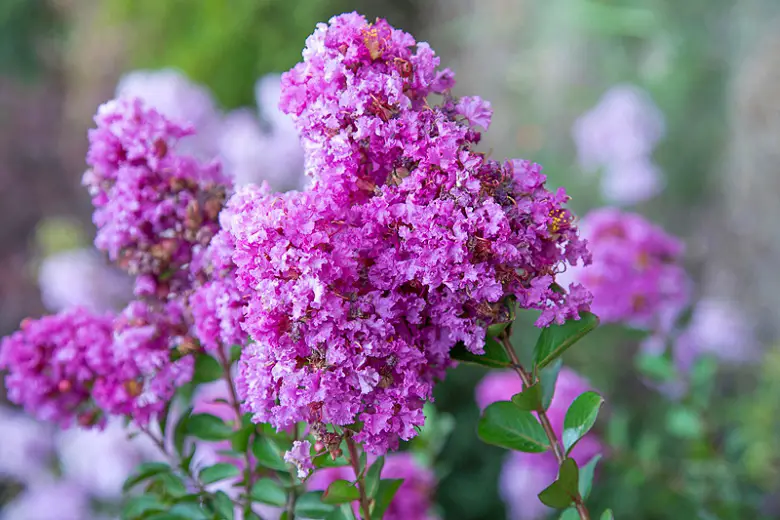Crape myrtles are beloved for their vibrant blooms and striking summer color. Understanding their growth patterns helps gardeners create a lush, thriving landscape with minimal effort. These versatile trees brighten any garden while offering long-lasting beauty year after year.
Timing, care, and proper techniques play a crucial role in their rapid growth. From choosing the right soil and sunlight to pruning and watering strategies, every step influences flowering and overall health. With the right approach, crape myrtles can transform ordinary spaces into stunning floral displays.
Understanding Crape Myrtle Growth Patterns

Crape myrtles exhibit unique growth patterns that vary by species and environment. Young trees often focus on root and stem development during the first years. This initial growth phase is crucial for establishing a strong foundation. Once established, branches expand rapidly, producing a fuller canopy. Growth speed depends on sunlight, water, soil quality, and overall care. Gardeners may notice periods of slow growth, particularly in early spring, as trees adjust to seasonal changes.
Height and spread also vary with variety. Dwarf or semi-dwarf types reach maturity faster but remain compact, while larger trees can grow taller and take longer to fill space. Seasonal growth cycles influence leaf production, flowering, and branch elongation. Understanding these cycles helps gardeners predict when to prune, fertilize, or water for optimal results. Climate plays a key role, as cooler regions may slow development, whereas warm, sunny environments accelerate growth and flowering.
Additionally, pruning history affects growth patterns. Proper pruning stimulates lateral branching and encourages stronger stems. Neglect or improper pruning can lead to weak, leggy growth and reduced flowering. Environmental stressors, such as drought or pests, temporarily slow growth but rarely halt it completely. By observing these natural patterns and responding with consistent care, gardeners can maximize the speed and health of their crape myrtles. Knowledge of growth tendencies ensures more predictable outcomes and vibrant, long-lasting blooms.
Factors Affecting Crape Myrtle Growth
Several factors influence how fast crape myrtles grow. Climate plays a crucial role, as these trees thrive in warm, sunny regions. Temperatures that are too cold or fluctuating can slow growth. Humidity levels also affect water uptake and disease susceptibility. Gardeners should select species suitable for their local climate to ensure optimal growth rates.
Soil quality and sunlight are equally important. Crape myrtles prefer well-draining, loamy soil enriched with organic matter. Compacted or heavy clay soil limits root expansion, reducing growth speed. Full sun exposure is essential for strong stems and abundant blooms. Trees growing in shaded areas develop slower, with sparse flowering. Amending soil and ensuring six or more hours of sunlight daily can dramatically improve growth.
Watering practices, fertilization, and pruning also impact development. Young trees require consistent moisture, but overwatering can cause root rot. Balanced fertilization supports foliage and flower production, while excessive nitrogen leads to leafy growth at the expense of blooms. Pruning stimulates branching and encourages a fuller canopy. Timing and technique are key to avoid stunting growth or removing potential flowers. By managing these factors carefully, gardeners can maximize growth rates, enjoy vibrant blooms, and ensure crape myrtles remain healthy and resilient for years.
Soil and Sunlight Requirements
Optimal Soil Conditions
Crape myrtles thrive in well-draining soil that is rich in organic matter. Sandy or loamy soils allow roots to expand easily. Heavy clay soils retain excess water, which can suffocate roots and slow growth. Amending soil with compost or aged mulch improves fertility and texture, providing essential nutrients.
Healthy soil supports strong root systems that anchor the tree and supply water and minerals efficiently. Young trees benefit the most from proper soil preparation, establishing quickly and growing rapidly. Regular soil testing ensures nutrient balance, while adding organic matter over time maintains soil health. By focusing on soil quality, gardeners can optimize crape myrtle growth and promote long-lasting blooms.
Maximizing Sunlight Exposure
Full sun is critical for fast-growing, healthy crape myrtles. Trees require at least six hours of direct sunlight daily to produce vibrant flowers and strong stems. Shaded areas reduce growth rate, resulting in sparse foliage and fewer blooms.
Selecting the right planting site enhances sunlight exposure and overall tree health. Pruning surrounding vegetation can prevent shading and improve light availability. Adequate sunlight also reduces disease risks by keeping foliage dry and well-ventilated. Combined with proper soil, sunlight management ensures crape myrtles grow vigorously, develop full canopies, and bloom abundantly throughout the season.
Choosing the Right Variety for Faster Growth
Selecting the correct crape myrtle variety significantly affects growth speed. Some cultivars naturally grow faster, while others are slow-developing. Hybrid varieties often combine rapid growth with disease resistance and abundant flowering. Understanding your climate zone helps determine which variety will thrive most effectively.
Fast-growing types are ideal for gardeners who want quick canopy coverage and early blooms. Slow-growing varieties may be better for small gardens or formal landscapes. Consider tree size, flower color, and overall appearance when selecting a variety. Matching growth habit to space ensures long-term success and reduces maintenance challenges.
Additionally, soil and sunlight preferences influence variety performance. Providing optimal conditions allows selected cultivars to reach their growth potential more quickly. Combining careful variety selection with proper care accelerates development, supports vigorous stems, and ensures abundant flowering. Planning with variety in mind enhances both aesthetics and garden functionality.
Watering and Fertilization Techniques
Proper Watering Practices
Consistent watering is crucial for crape myrtle growth, especially for young trees establishing roots. Newly planted trees need regular, deep watering to encourage strong root development. Shallow or irregular watering can stress the plant, slowing growth and reducing flowering potential. During hot, dry periods, provide extra irrigation to maintain soil moisture without waterlogging roots.
Mulching around the base helps retain soil moisture and moderates temperature. Avoid watering directly onto leaves to reduce fungal disease risk. Using drip irrigation or soaker hoses ensures even moisture distribution. Mature trees tolerate occasional dry spells better, but consistent watering encourages steady growth, lush foliage, and longer bloom periods. Proper watering practices prevent stress, strengthen the tree, and create ideal conditions for rapid growth.
Effective Fertilization
Fertilization supports strong growth, vibrant foliage, and abundant blooms. A balanced, slow-release fertilizer provides essential nutrients over time. Avoid high-nitrogen fertilizers, which encourage leafy growth at the expense of flowers. Fertilizing in early spring and again mid-season optimizes growth and flowering performance.
Compost and organic matter enrich the soil naturally, improving texture and nutrient availability. Regular feeding strengthens the root system, making trees more resilient to stress. Over-fertilization can damage roots and reduce overall health. By combining proper fertilization with watering and sunlight management, gardeners can maximize growth rates, enhance bloom quality, and maintain crape myrtles that flourish year after year.
Watering Strategies to Support Rapid Growth
Proper watering directly influences crape myrtle growth. Consistent moisture encourages strong root development. Newly planted trees require more frequent watering to establish roots. Mature trees benefit from deep, less frequent watering, which promotes drought tolerance and supports vigorous growth.
Avoid overwatering, which can suffocate roots and reduce growth speed. Well-drained soil ensures water reaches roots without pooling. Mulching helps retain soil moisture, moderates temperature, and reduces evaporation.
Seasonal adjustments improve results. In hot summer months, increase watering slightly to prevent stress. During cooler or rainy periods, reduce watering to prevent fungal issues. Combining proper watering techniques with pruning and fertilization accelerates growth and encourages healthy flowering. This holistic approach ensures trees reach their full potential quickly.
Using Fertilization to Promote Rapid Growth
Proper fertilization encourages fast crape myrtle growth. Balanced fertilizers support healthy roots, stems, and foliage. Nitrogen, phosphorus, and potassium each play critical roles in overall plant development. Applying fertilizer in early spring maximizes nutrient uptake before active growth begins.
Slow-release fertilizers provide consistent nutrition over time. Over-fertilizing can cause excessive leaf growth at the expense of blooms. Organic options, such as compost or well-rotted manure, improve soil structure and supply essential nutrients. Regular feeding during the growing season ensures sustained energy for rapid development.
Fertilization also supports pest and disease resistance. Well-nourished trees withstand environmental stress better than nutrient-deficient plants. Coupled with proper watering and pruning, fertilization accelerates growth, encourages a fuller canopy, and improves flowering performance. This strategic approach results in healthier, faster-growing crape myrtles.
Optimizing Soil Conditions for Faster Growth
Soil quality significantly affects growth rate. Crape myrtles prefer loamy, well-draining soil rich in organic matter. Soil pH slightly acidic to neutral enhances nutrient uptake. Poor or compacted soil slows root development and overall growth.
Amending soil before planting improves structure and fertility. Incorporating compost or organic matter increases microbial activity, strengthens roots, and supports rapid growth. Mulching maintains consistent soil conditions, reduces weeds, and retains moisture.
Regular soil testing ensures nutrient balance. Adjusting fertilization based on soil results maximizes efficiency. Well-prepared soil combined with proper sunlight, watering, and pruning accelerates growth. Gardeners see stronger stems, more shoots, and faster canopy expansion when soil conditions are optimal.
Pruning for Faster Growth
Pruning plays a key role in encouraging rapid crape myrtle growth. Removing dead, damaged, or crossing branches allows the tree to focus energy on healthy stems. Proper pruning enhances air circulation, reducing disease risk and supporting stronger, faster-growing branches. Timing is critical; prune in late winter or early spring before new growth begins to maximize results.
Shaping the tree also stimulates branching, creating a fuller canopy. Cutting back long, leggy stems encourages multiple shoots to develop. Avoid over-pruning, which can stress the tree and reduce flowering. Use sharp, clean tools to make precise cuts and minimize damage. Maintaining proper structure through pruning ensures long-term health and supports consistent, vigorous growth year after year.
Regular maintenance pruning throughout the growing season promotes continuous growth. Remove spent blooms and thin crowded branches to redirect nutrients toward new growth. Light summer pruning can improve bloom quality and tree appearance without harming overall development. By combining strategic pruning with proper soil, sunlight, watering, and fertilization, gardeners can achieve fast-growing crape myrtles with abundant flowers and strong, resilient canopies that enhance any landscape.
Maximizing Growth Through Strategic Pruning
Strategic pruning promotes vigorous growth in crape myrtles. Removing weak, dead, or crossing branches redirects energy toward stronger stems. This encourages rapid canopy development and improved flowering potential. Proper timing is critical; late winter or early spring pruning produces the best results.
Shaping the tree enhances light penetration and air circulation. This reduces disease risk while stimulating multiple shoots for fuller growth. Avoid over-pruning, which can stress the tree and slow development. Consistent maintenance pruning throughout the season maintains structure and supports rapid growth.
Additionally, selective summer pruning can remove spent blooms and encourage new growth cycles. Combining pruning with fertilization, watering, and pest management optimizes overall growth speed. Gardeners who follow these practices achieve faster canopy expansion, stronger branches, and abundant seasonal flowering, enhancing the beauty and health of their crape myrtles.
Seasonal Care Tips to Promote Year-Round Growth
Seasonal care is crucial for maintaining healthy, consistent growth in crape myrtles. In spring, focus on preparing the soil and pruning dead branches. Early fertilization encourages strong leaf and stem development. Regular watering during dry spells helps young trees establish roots. Monitoring for pests early in the season prevents infestations from spreading. Spring care sets the foundation for abundant flowering later in the year.
During summer, continued watering and mulching support growth and flower production. Mulch retains soil moisture and regulates temperature. Remove spent flowers to redirect energy toward new blooms. Light pruning of weak or crowded branches maintains air circulation and prevents disease. Consistent attention to pests and fungal issues ensures the tree remains healthy throughout the hottest months. Summer care maximizes flowering potential and overall plant vigor.
In fall and winter, gradually reduce watering and prepare the tree for dormancy. Remove fallen leaves and debris to minimize disease risk. Protect young or sensitive trees with burlap or frost cloth in colder regions. Avoid heavy pruning, focusing only on damaged or crossing branches. Seasonal preparation helps the crape myrtle survive winter stress and return in spring with rapid, vigorous growth. Following these seasonal routines ensures a thriving, year-round landscape presence.
Pest and Disease Management
Common Pests and Their Control
Crape myrtles face pests such as aphids, scale insects, and Japanese beetles. These insects damage leaves, stems, and flowers. Early detection is essential to prevent infestations from spreading and harming tree health. Regular inspection of foliage and branches allows gardeners to identify issues promptly.
Natural predators like ladybugs and lacewings control aphid populations effectively. Insecticidal soaps or horticultural oils provide safe chemical control when infestations are severe. Avoid overusing pesticides to protect beneficial insects. Maintaining overall tree health and monitoring pest activity reduces damage and supports abundant flowering, ensuring crape myrtles remain vigorous and resilient.
Managing Diseases
Fungal diseases like powdery mildew, leaf spot, and sooty mold commonly affect crape myrtles. These pathogens thrive in humid, poorly ventilated conditions. Proper pruning ensures good air circulation, reducing disease risks. Avoid overhead watering to minimize leaf wetness, which promotes fungal growth.
Choosing disease-resistant varieties provides long-term protection against common infections. Remove and dispose of infected leaves properly to prevent pathogen spread. Fungicidal treatments may be applied for severe cases, following label instructions carefully. Combined with consistent monitoring and preventive care, these practices keep crape myrtles healthy, vigorous, and capable of producing vibrant, long-lasting blooms year after year.
Mulching and Ground Care
Benefits of Mulching
Mulching around crape myrtles helps retain soil moisture and regulate temperature. It creates a protective layer that reduces water evaporation and prevents soil from overheating. During summer, mulch keeps roots cool and hydrated. In winter, it insulates the soil, protecting roots from frost damage. Organic mulch also breaks down over time, adding nutrients and improving soil structure.
Mulching also suppresses weeds that compete for water and nutrients. By reducing weed growth, crape myrtles can focus energy on branch development and flowering. Proper mulching depth, about two to three inches, ensures effectiveness without suffocating roots. Avoid piling mulch against the trunk to prevent rot and pest infestation. Consistent mulching enhances both the health and aesthetic of your landscape.
Ground Care Practices
Maintaining the ground around crape myrtles promotes strong growth and reduces disease risk. Keep soil well-drained to prevent root rot. Aerate compacted soil to improve oxygen flow to the roots. Removing debris, fallen leaves, and weeds prevents pests and fungal infections. Healthy soil supports vigorous flowering and reduces stress on the tree.
Regular monitoring of soil pH is also important. Crape myrtles prefer slightly acidic to neutral soil for optimal nutrient absorption. Amend soil with compost or organic matter to enhance fertility. Avoid heavy foot traffic near the root zone to prevent compaction. With proper ground care, your crape myrtles will grow faster, bloom more abundantly, and remain resilient against environmental challenges.
Fall and Winter Care
Fall Preparation
As temperatures drop, crape myrtles need careful fall care. Gradually reduce watering to prevent root stress. Remove fallen leaves and garden debris to reduce fungal disease risk. Lightly fertilize trees to strengthen roots before winter dormancy. Young or sensitive trees benefit from frost protection using burlap or frost cloth in colder regions.
Pruning should be limited to removing damaged or crossing branches. Avoid heavy pruning, which can stimulate late growth vulnerable to frost. Mulching around the base helps retain soil warmth and moisture. Fall care ensures the tree survives dormancy, returns in spring with strong stems, and produces vibrant flowers. Regular observation during this period prevents pests or disease from affecting tree health. Proper fall preparation supports long-term growth and abundant flowering in the following season.
Winter Care
During winter, crape myrtles enter dormancy, requiring minimal maintenance. Watering should be occasional, enough to keep roots alive but not soggy. Protect trees from extreme frost or ice accumulation, especially young plants. Avoid fertilization or heavy pruning, as the tree is not actively growing.
Monitor for winter pest activity or fungal problems. Remove any damaged limbs caused by ice or snow. Proper winter care preserves tree structure and prepares crape myrtles for vigorous spring growth. Healthy winter practices increase resilience to disease, support rapid growth, and enhance blooming potential. By combining fall preparation with attentive winter care, gardeners ensure crape myrtles remain robust, productive, and visually appealing year after year.
FAQ About How Fast Crape Myrtles Grow
How fast do crape myrtles grow?
Crape myrtles grow at different rates depending on variety, climate, and care. Dwarf types grow slower, reaching maturity in a few years, while larger varieties can grow up to 12–24 inches per year. Adequate sunlight, water, and soil fertility significantly impact their growth speed and overall health.
When is the best time to plant crape myrtles?
The optimal planting time is early spring or fall when temperatures are mild. Planting during these periods allows roots to establish before summer heat or winter cold. Ensure well-draining soil and sufficient sunlight to promote strong initial growth and abundant flowering in subsequent seasons.
How should I water crape myrtles for rapid growth?
Young crape myrtles require regular deep watering to establish roots. Mature trees benefit from weekly watering during dry spells. Avoid overwatering, as soggy soil can lead to root rot. Mulching helps retain moisture and keeps soil temperatures consistent, promoting steady growth and healthier flowering.
What pruning techniques encourage faster growth?
Prune in late winter or early spring before new growth begins. Remove dead, crossing, or weak branches to improve airflow and light penetration. Light shaping and thinning encourage lateral branching and stronger stems. Proper pruning increases flower production and maintains the tree’s structure while supporting rapid seasonal growth.
Which pests and diseases affect crape myrtles most?
Common pests include aphids, Japanese beetles, and scale insects, which damage leaves and flowers. Fungal diseases like powdery mildew and leaf spot thrive in humid conditions. Early detection, good air circulation, and proper pruning reduce risks. Natural predators and safe insecticides help manage infestations effectively.
Conclusion
Understanding how fast crape myrtles grow allows gardeners to plan and maintain a vibrant landscape. By choosing suitable varieties, providing optimal soil, sunlight, and water, and practicing proper pruning, your trees will thrive quickly and bloom abundantly. Seasonal care, mulching, and pest management further enhance growth and longevity. Whether you aim for a colorful backyard display or a flourishing garden border, consistent attention ensures success. With these expert tips, anyone can enjoy the beauty, resilience, and rapid growth of crape myrtles, transforming outdoor spaces into a stunning floral showcase year after year.






